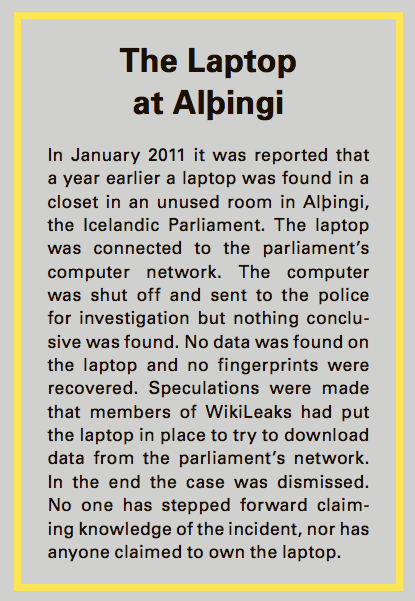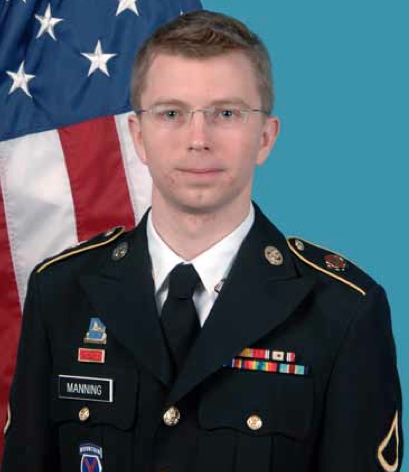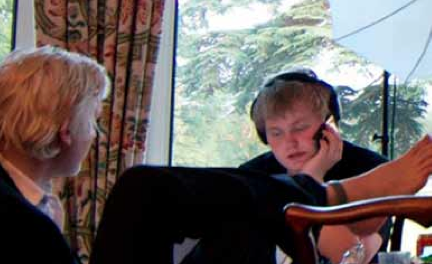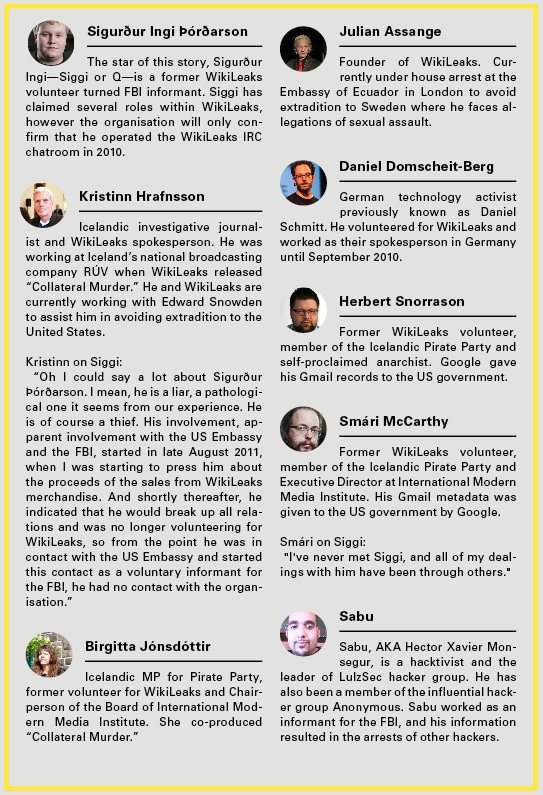In early 2010, a young man was arrested in Reykjavík on charges of stealing sensitive documents from local financial company, Milestone, which had made their way into news stories in the Icelandic media. The man, seventeen at the time, had worked for the company doing computer related work for a few years. His name is Sigurður Ingi Þórðarson and for the next year and a half he became a part of the whistleblowing association WikiLeaks, operating under the alias ‘Q’. In a stunning move, he became an FBI informant in August 2011, mostly providing the United States law enforcement agency with information on WikiLeaks, among them eight data-filled hard drives.
When news came out that Sigurður was an informant, WikiLeaks representatives swore off any connections to him, while the media reported that he was in an unstable mental state and had been admitted to a mental institution. In the past two years, Sigurður Þórðarson has been widely discredited, repeatedly called a pathological liar and/or a psychopath, and sued for embezzlement while remaining entangled in a far-reaching and complicated saga that has had astonishing consequences for the Western worldview in the 21st century.
This is his side of the story.

“I was arrested for the Milestone leak in late January 2010. Kristinn Hrafnsson called me after that, I had been providing him with documents [the Milestone leak], and he wanted me to meet this guy named Julian Assange. I had no idea who he was at the time. I tried googling him, but I didn’t come up with much. I found one YouTube video of a radio interview with him, and I just thought that he was like 90% of the activists out there, who say they are going to do all kinds of things and then nothing comes of it. But my schedule was open, so I went to see him give a talk on whistleblowers at a local university.”
“When I walked into the auditorium, he was telling off a journalist who outed me on the front page of his newspaper as the provider of the Milestone documents, so my first impression was great. I introduced myself to him after the talk and he said that Kristinn had mentioned me. We then talked for three or four hours. He ended up giving me a crypto phone to use for contacting him. I was seventeen; I had no idea about anything like this and thought it was very cool. The next weeks we met daily. We went and bought two laptops—by some strange coincidence, they were of the same make and model as the laptop that was later found in Alþingi.”

Collateral Murder
“We started meeting regularly, him and me and some Icelanders. Usually at the restaurant Sægreifinn by the harbour. Assange really liked their lobster soup. Then one day Birgitta Jónsdóttir, a local MP for the Movement, picked me up from a café downtown and we went to her home, where Assange showed me the “Collateral Murder” video. This was in February or March of 2010.”
“I remember that night especially well. I had never seen a video like it before. It was like watching a movie or a computer game. Later, I went to a friend’s house, where some peo- ple were playing “Call of Duty” [a war-simulation videogame]. I looked at it and thought, ‘wow; this is exactly the same as the video I just saw.’ The day after, I met with Assange, and he told me that there was more material of the same kind coming in. I felt like I was in a spy movie. It was exciting.”
“Assange then left Iceland and I continued working for him. Do- ing research and things like that. He gave me another laptop and things were going great. And then the “Collateral Murder” video gets published. I was on the phone with Kristinn Hrafnsson that day. He was in Iraq. Everything went crazy. I continued to keep contact with Assange over the Internet and I hung out in the WikiLeaks IRC chatroom. Then, that summer, a number of people left WikiLeaks, Daniel Domscheit-Berg, Herbert Snorrason and Smári McCarthy for example. That’s when my role within the organisation changed.”

Photo Courtesy of Sigurður Ingi Þórðarson
Chief of staff
“I essentially took over the organisation’s IRC chatroom. WikiLeaks was getting really famous at that point, and all kinds of individuals were joining in the conversation on the chatroom. A lot of media agencies and people wanting to volunteer for WikiLeaks joined. At that time, the key-group running WikiLeaks num- bered 6 or 7 people, which was pretty small for the work we were doing at the time. So it was decided to use the people who joined the chat, if they wanted to help. We set up around 100 groups that each numbered from 10 to 20 people. These were all individuals that I handled for WikiLeaks. Their only connection to the organisation was through me. The tasks came from Assange or whomever needed work done. Some involved programming, some involved research. It all went very well at that time.”
“Instead of explaining my role for each and every volunteer, it was easier to just tell them that I was Chief of staff or Chief of volunteers. In reality, WikiLeaks had no official titles or roles, but this was just easier to say.”
Growing pains
“Then the WikiLeaks servers crashed and we needed a new web page, a new submission system and a way to finance the organisation. I got volunteers to research ways to finance this, and I assigned others to make a new web page. We had some Dutch volunteers working on a new submission system. It got pretty far, but Assange was reluctant to launch it. I never really understood why. I guess he didn’t really trust that they weren’t putting backdoors into the system.”
“The situation was all one big chaos. But we got the new web up and I received a report on possible ways to finance the organisation. The one idea that I liked was selling WikiLeaks branded merchandise. Kristinn Hrafnsson said that the idea was total bullshit, that it would never work. I discussed it with Assange and he was also unsure. In the end, I just went ahead with it, deciding to take on the losses if the project would fail. I put my bank account on the line for this, as there was trouble at the time with Visa and MasterCard not accepting donations to WikiLeaks. Everybody was happy with it. Assange said to me: just put it into your account.”
Anonymous and LulzSec
“In June or July of 2011, we got in contact with the hacker groups Anonymous and LulzSec. I initiated the contact, but it was with the approval and initiative of Julian Assange. At the time, I discussed this with Assange and he said that he didn’t care where the information comes from, as long as we had something to publish.”
“An Icelander contacted me with the idea of accessing the data servers of the Icelandic Ministry of Finance. I forward the idea to Anonymous and LulzSec, and what essentially happens as a result is that all the computer systems for the national power company, Landsvirkjun, and the Government offices go offline.”
“That’s when I started realising that this might be fun, but that it was also wrong. I was in touch with the hacker Sabu, who kept constantly pushing documents to me. Information on BP Oil, HSBC in Mexico, the Stratfor emails [in February of 2012, WikiLeaks published emails from the global intelligence company Stratfor’s employees and its clients, referred to as the Global Intelligence Files] I thought it was interesting, but I was reluctant in forwarding it to WikiLeaks. Sabu was different from other sources that needed you to take initiative. He was always like ‘Hey, here’s some documents, here’s some documents!’ It was out of the ordinary. I was at the time involved with FBI and LulzSec, and I had no idea Sabu was also an FBI informant.”
“Eventually, I told Julian that I didn’t want to accept these documents from him, because they were obtained illegally. That’s when our disagreement starts.”

Bradley Manning – Photo Courtesy of the US Army
Contact with the FBI
“Around August 24, 2011, I emailed the United States Embassy in Reykjavík in the middle of the night, saying that I have some information they might be interested in. They called me back the next morning, and I met with them for maybe 20 minutes. They told me that it was unlikely that I’d be contacted again, but if it happened then it would be in a few weeks. Then, the following morning at 10, my phone rang, it was them requesting another meeting. I rushed to the embassy, and a man I met there asked me if we could take a walk. We ended up at the hotel Reykjavík Centrum. Two men were sitting by the bar. The man from the embassy leaves and the two men come over and show me identification, stating that they are FBI agents. It felt like a movie.”
“They had brought a team of nine people. They said that a woman from the Icelandic justice department was there, and that she wanted to speak with me before we talked. I had said to the embassy that I did not want the Icelandic authorities involved, that I did not trust them, but I agreed to talk to the woman. They went to get her, but by then she had left. The Ministry pulled her out. We talked for the next four, five days at various hotels in the city.”
Leaking
“The agents told me that they wanted my data, that they wanted to know more but couldn’t operate in Iceland any longer. So they asked me to join them somewhere. They said that I could pick any country in world, any state in the USA. I tell them that I’m not going to the USA—that would be a one-way ticket. I suggest Moscow, Russia, which they didn’t find funny, explaining that their relations with the Russian secret service community wasn’t so hot. We wound up going to the closest country, Denmark.”
“Before I left for the airport I got a text message saying that I should pretend to not know the agents while travelling and that we will only speak after landing. At the airport they all pretend not to know one another, or me, but wherever I went they followed me. In Copenhagen we checked into the Hilton hotel by the airport. To the best of my knowledge, the Danish authorities were not involved. I doubt that they would have been happy with the FBI interrogating an Icelandic citizen in Denmark. We stayed there for 24 hours talking, and their technicians cloned some hard drives that I brought with me.”
Leaving WikiLeaks
“In September, October 2011, I left WikiLeaks. The organisation owed me money at some point, 7–800 thousand ISK. It was accumulated costs for flights, hotels, and travel for Assange’s bodyguards. When I hadn’t been paid for six weeks, I asked Assange if it was OK for me to use the money coming in from the WikiLeaks merchandise shop I had set up, to cover my costs. He said that was fine. I used money from the shop for WikiLeaks related things, buying computers and supplies for volunteers and such.”
“When I left, WikiLeaks asked me to return all the receipts so that they could confirm the accounts. They wanted me to repay all the money, and then pay me back when they’d verified the receipts. I told them that I had no way of repaying 5-6 million ISK on the spot. I knew that WikiLeaks was in financial trouble and owed 3 million Euros in legal fees, so I asked if they were really going to pay me back if I handed over the money. They said they would, but that it could take three months. I reply that they can have the receipts, but that’s as far as I’m willing to go. In May of 2012, they filed charges in Iceland against me for embezzlement, saying that I was involved in fraud and forgeries.”
“I was interrogated by the Icelandic police, but the merchandise shop was in my name. I do not deny that I’ve deceived people and forged things in other cases, but not regarding WikiLeaks. Eventually the case was dropped due to lack of evidence.“
Travelling with the FBI
“In October 2011 I again met with the FBI in Denmark. We stay at five star hotels, and regularly go to McDonalds. It was exciting. They knew that I’d left WikiLeaks at the time, but still kept pressuring me to go and visit Julian Assange in the UK. They wanted me to wear a special watch that could record sound. I told them no, just as I had done in August when they brought it up then. They wanted to know if I feared for my safety, if I was afraid Assange would attack me. I told them, Assange isn’t a violent man.”
“In February of 2011, they flew me to Washington where we talked for four days. Intelligence analysts from all kinds of three letter acronym institutions joined. We talked about individuals, about Assange’s physical security; who his bodyguards are and such. They were mostly interested in Assange, but also in Icelanders like Birgitta Jónsdóttir, Smári McCarthy, Herbert Snorrason and Kristinn Hrafnsson. They explained that if I wanted, I could walk out anytime, and requested that I refrain from recording the sessions. I thought that was understandable.”

Photo Courtesy of Sigurður Ingi Þórðarson
Outed
In January of this year, WikiLeaks spokesman Kristinn Hrafnsson was interviewed by local news programme, Kastljós, revealing that the FBI had conducted an investigation into WikiLeaks in Iceland.
“Kristinn didn’t know it was me who had been interrogated, not until I phoned him. ‘It was me who they were talking to,’ I told him. I swear he went silent for a full minute—I could tell he was fuming on the inside—and then he said that I shouldn’t talk to any media. I replied with ‘If you can do it, why can’t I?’ He became furious. He’s the only person that I’ve ever been afraid of. This was the last time I had direct contact with Kristinn, all our interactions have taken place through third parties after this.”
“The same day that the story broke in the Icelandic media, I’m on my way to Amsterdam. I got a phone call from an Icelandic journalist. He told me that he has sources saying that I’m in a mental institution, that I have mental problems and that my history with the police is long. He made me an offer: ‘You give us an interview on this FBI case and then we won’t publish that.’ I told him no, but offered to send him any information on me that he wants, medical records, to disprove the mental problem allegations. He then says that he’s not interested in this. Later that day I read in the media that I was in a mental institution.”
“I know who his source was, it’s a person I used to work with at a security company and whom I once hired to be a bodyguard for WikiLeaks. He was present when I met with the FBI in Denmark and he told this Icelandic journalist that I had gotten paid for providing information and made up a lot of stories. I’ve never bothered discussing things with the media. My experience with that is not good.”
Whistleblowing or leaking
“I don’t view Bradley Manning or Edward Snowden as whistleblowers, I view them as leakers. They leaked information. There is a great difference. Bradley Manning just leaked everything. To whistleblow is to expose something criminal. Less than 10% of what he leaked showed something that could theoretically be criminal, and maybe 1% was criminal behaviour. That’s the big difference. Who cares if a United States ambassador buys a pink toothbrush? This is information that does not need to be disclosed. Edward Snowden leaked information on legal activities. The spying is legal, Congress and judges approve it. Do I think the treatment they’ve received is fair? No, not at all. But I don’t view them as whistleblowers.”
“To say that Iceland is a country for whistleblowers is like saying that we all live in igloos. It’s equally out of touch with reality. Like IMMI, it was named ‘the Icelandic Modern Media Initiative’ and now its named ‘Icelandic Modern Media Institute.’ And what have they done? Nothing. I was arrested for leaking information, I tried what I could. You could say that I tried to ‘save the nation’ by leaking information.”
“I whistleblew on the whistleblowers. I know that there were some things that Assange and others connected with WikiLeaks, me included, did where laws were broken, both in Iceland and the United States. I don’t know what happens next. I’m not going to the USA in the near future. In my last meeting with the FBI they discussed the possibility that I would testify in court. I told them I’d decide on that if it would come to that.”
Sigurður Þórðarson says that he has no contact with Assange today.

Photos in sidebar by Árný Herbertsdóttir, Julia Staples, www.newmediadays.com — Peter Erichsen SHARE conference, and JD Lasica
—
WikiLeaks Timeline – From 2007 to present
December 2007 – WikiLeaks launches official website.
August 2009 – Kaupþing Bank secures court order preventing Iceland’s national broadcaster, RÚV, from broadcasting WikiLeaks reports showing Kaupþing Bank loaned suspiciously large sums of money to various owners of the bank, and large debts were written off before the collapse of the banking sector.
February 2010 – Julian Assange advises Icelandic Modern Media Initiative proposal that Iceland, “strongly position itself legally with regard to the protection of freedoms of expression and information.”
– Sigurður Ingi Þórðarson, Siggi, Q, begins working for WikiLeaks.
March 2010 – Julian Assange claims US government was spying on WikiLeaks activities in Reykjavík.
April 2010 – WikiLeaks releases video of US Apache military helicopter killing Iraqi civilians and two Reuters journalists, a.k.a. ‘Collateral Murder,’ with the help of Icelandic volunteers.
June 2010 – US soldier Bradley Manning arrested for supplying confidential documents to WikiLeaks.
July 2010 – WikiLeaks publishes Afghan War Diaries: 92,000 documents of US military memos.
August 2010 – Swedish police issue arrest warrant for Assange on two separate allegations of sexual assault.
September 2010 – Birgitta Jónsdóttir calls for Assange to step down during his personal legal battles.
October 2010 – WikiLeaks publishes Iraq War logs: 400,000 documents on the Iraq War from 2004–2009.
November 2010 – WikiLeaks releases 250,000 confidential US diplomatic/embassy cables with incriminating information about US foreign relations and activities.
December 2010 – Julian Assange gives himself over to London’s police, awaits extradition to Sweden on sexual assault charges.
August 2010 – Prominent WikiLeaks staffers quit the organisation in protest of Julian Assange’s leadership and insufficient redactions in Iraq War Logs.
January 2011 – Birgitta Jónsdóttir fights US government’s demand for her Twitter account details.
July 2011 – Julian Assange appeals extradition.
August 2011 – Sigurður Ingi Þórðarson approaches US embassy in Reykjavík with information about WikiLeaks
November 2011 – The British High Court rejects Julian Assange’s appeal.
June 2012 – Assange files for political asylum at Ecuador’s embassy in London, takes refuge there.
July 2012 – The Reykjavík District Court rules that Valitor, which handles Visa and MasterCard payments in Iceland, was in the wrong when it prevented cardholders from donating funds to the WikiLeaks site.
August 2012 – Julian Assange is offered asylum in Ecuador.
September 2012 – Julian Assange addresses the UN in support of Bradley Manning and the Arab Spring while criticising President Obama for “criminalizing more speech than all previous US presidents combined.”
December 2012 – Bradley Manning pleads guilty to 10 of 22 charges.
June 2013 – Icelandic former director of Data-Cell Ólafur Vignir Sigurvinsson says a chartered jet is prepared to transport Edward Snowden to Iceland.
– Julian Assange brokers discussion of political asylum between Edward Snowden and the Government of Iceland.
– Sarah Harrison of WikiLeaks accompanies Snowden on flight from Hong Kong to Moscow. Julian Assange tells reporters that he paid for Snowden’s lodgings in Hong Kong and his flight out of the country.
– Julian Assange hails Snowden as a “hero” who has exposed “one of the most serious events of the decade—the creeping formulation of a mass surveillance state.”
– Assange released a statement asking people to “step forward and stand in” with Snowden.
July 2013 – Bradley Manning’s lawyers seek to dismiss charges of aiding the enemy.
– WikiLeaks reveals Snowden applied for political asylum in 20 countries.
—
THE OTHER SIDE of Siggi The Hacker
Name: Sigurður Ingi Þórðarson
DoB: October 12, 1992 Astrology sign: Libra
Eyes: Blue
Distinctive feature: That’s a good question.
Education: College
Favourite...
Food: Oven roasted chicken with bell pepper BBQ sauce
Drink: Coca Cola
Film: Forrest Gump
Video game: Hitman
Song: n/a
Band: n/a
Book: The Unauthorized Biography of Julian Assange
Artist: n/a
Leisure activity: Outdoor activities
City: Washington DC, there are such interesting people there
WikiLeaks character: Joseph
Radio station: Flassback
Actor: n/a
Icelandic MP: Birgitta Jónsdóttir international
Politician: Hillary Clinton
Dessert: Chocolate Mousse
What’s the most fun thing you’ve done? Travelling. My travel partner was even crazier than I.
What’s the craziest thing you’ve done? I’m not allowed to tell.
What would you bring to a desert island? A cell phone tower, a 3G stick and a laptop.
Which country do you most want to visit? Russia
Which country do you least want to visit? The United States
Where would you rather go, a space station or the bottom of the sea? Space station, it has better view.
Of what achievement are you most proud? Running up the Eiffel tower with a box of strawberries for provisions.
Kanye or Jay-Z? Who?
What would your dream day be like? For McDonalds to come to Iceland.
What’s the wackiest thing you’ve found out during your hacking exploits? How unsafe Icelanders are.
Does the Illuminati exist? Did you find out anything about them while hacking? No comment.
—
Additional reporting from Adrienne Blaine, Shea Sweeney, Tómas Gabríel Benjamin and Kaisu Nevasalmi
—
This article is part of our issue 10 feature, which spotlights the ongoing, interconnected saga of WikiLeaks, IMMI and the rise of the surveillance state.
Read WikiLeaks spokesperson Kristinn Hrafnsson’s response here.
Read informant Adrian Lamo’s comments on the case of Siggi here.
Read about espionage in Iceland here.
Read about the US’ attempts to gather intelligence on WikiLeaks head Julian Assange by spying on Icelanders (including an MP) here.
Read about the dead or dying dream of Iceland as “whistleblower haven” here.
Buy subscriptions, t-shirts and more from our shop right here!















